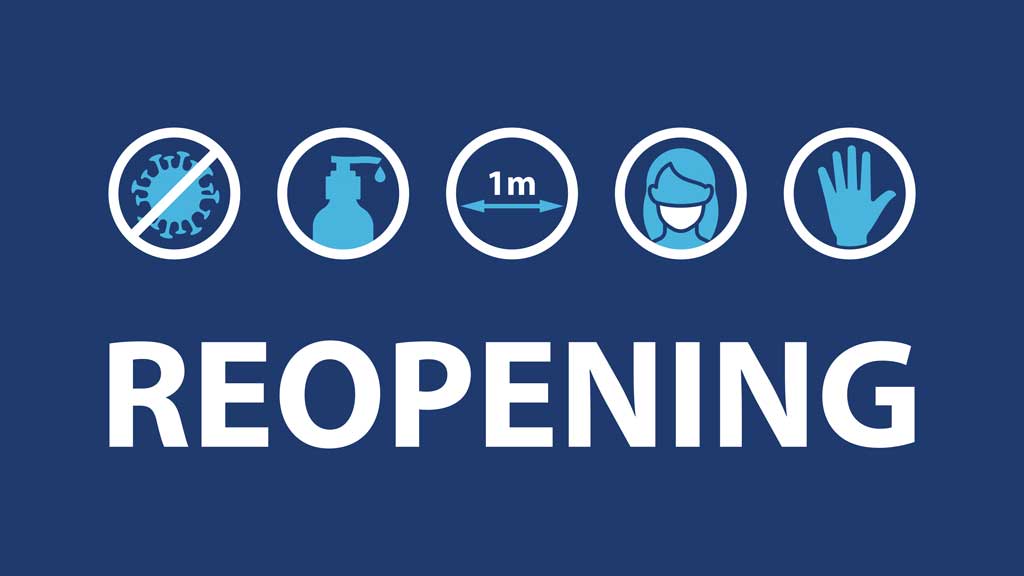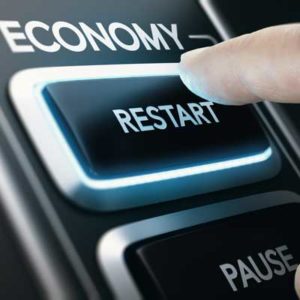States are lifting their coronaviruscoronavirus co·ro·na·vi·rus : any of a family (Coronaviridae) of single-stranded RNA viruses that have a lipid envelope studded with club-shaped projections, infect birds and many mammals including humans, and include the causative agents of MERS, SARS, and COVID-19 stay-at-home orders at a fierce clip, even as the number of U.S. COVID-19COVID-19 \ ˈkō-vid-nīn-ˈtēn : a mild to severe respiratory illness that is caused by a coronavirus (Severe acute respiratory syndrome coronavirus 2 of the genus Betacoronavirus), is transmitted chiefly by contact with infectious material (such as respiratory droplets), and is characterized especially by fever, cough, and shortness of breath and may progress to pneumonia and respiratory failure. cases has surpassed 1.5 million and more than 90,000 deaths have been reported.
The strain on the economy is a main driver for the return to more regular business operations. The United States has seen about 9 straight weeks of record unemployment numbers once the latest numbers come out this Thursday. More than 36.5 million have filed for unemployment with more than 27 million Americans losing their employer-based health insurance plans as a result.
More than 4 million homeowners are skipping their mortgage payment and in forbearance plans now, according to the latest data from the Mortgage Bankers Association. Some states have adopted legislation to protect homeowners from foreclosure during the COVID-19 crisis.
Meanwhile, experts predict the coronavirus pandemic may take two years to run its course.
Impact on Businesses
Retail sales were down 16.4% in April, and about a third of closed businesses surveyed by Facebook said they do not expect to reopen, with many citing an inability to pay bills or rent. More than half reported they won’t rehire the same workers when they reopen. The State of Small Business Report surveyed 86,000 small- and medium-sized businesses, managers and employees in an effort with the World Bank and Organization for Economic Cooperation and Development.
In a U.S. Census Bureau Small Business Pulse Survey, 31.4% expect more than six months will pass before their business returns to its usual level of operations.
In fact, 40% of Americans say they fear they will never retire because of the COVID-19 pandemicpandemic (pan·dem·ic) : an outbreak of a disease that occurs over a wide geographic area and affects an exceptionally high proportion of the population : a pandemic outbreak of a disease., according to the May 2020 Simply Wise Retirement Confidence Index.
 Where States Stand on Reopening
Where States Stand on Reopening
Stay-at-home orders in response to the coronavirus pandemic lifted in several states beginning May 1, and every state will have begun lifting measures by Memorial Day. Most school systems will remain closed through mid-May or for the remainder of the academic year. A draft 17-page CDC business plan with guidance on reopening was never finalized; however it lays out phased reopening plans and sanitation guidelines for child care facilities, houses of worship, offices, restaurants and bars, and mass transit.
Some universities are planning abbreviated fall semesters to end in-school instruction before the fall flu season is expected to start in late November.
New York Governor Andrew Cuomo has extended the stay-at-home order for the NYC metro area until June 13 unless conditions are met.
Georgia, Oklahoma, Alaska, Arkansas, Texas, Florida, North Dakota, Nebraska, Tennessee and Idaho in early May had begun reopening parts of the economy. Idaho’s four-phase plan reopened 90% of businesses, so long as they take steps to maintain proper social distancingsocial distancing :the avoidance of close contact with other people during the outbreak of a contagious disease in order to minimize exposure and reduce the transmission of infection. and sanitation protocols. Several others are considering partial returns to pre-coronavirus activity and others have announced conditions that must be met before reopening.
- In Oklahoma, dining facilities, gyms, theaters and places of worship were allowed to reopen May 1, as long as they adhere to certain health guidelines.
- Alabama began reopening the state’s beaches, restaurants and retail stores May 1 as the state began its phased return to business. Alabama could reopen its schools beginning in June for summer school and school activities. The state has asked superintendents to consider moving the start of the 2020/2021 school year to later in August.
- The governor of Kentucky announced certain public health criteria the state will have to meet before reopening parts of the economy, including having 14 days where coronavirus cases are decreasing.
- In Texas, in-store retail services, dine-in restaurant service, movie theaters, shopping malls, museums and libraries were reopened with 25% occupancy under certain conditions. Child care centers, youth sports clubs, massage and tattoo parlors and bars are set to open with limitations at the end of the month. Schools will not reopen this school year. (Utah has reopened under similar conditions.)
- Iowa lifted certain restrictions in select counties starting May 1.
- In Tennessee, retailers and restaurants began reopening at 50 percent capacity in 89 of the state’s 95 counties.
- Mississippi Gov. Tate Reeves announced restaurants and parks could reopen with restrictions beginning May 7.
- Wyoming extended restrictions for gatherings of more than 10 people through May 15.
- West Virginia announced a phased reopening plan, “West Virginia Strong – The Comeback,” beginning with elective medical operations followed by businesses with fewer than 10 employees.
- Virginia’s stay-at-home order extends until June 10, the longest statewide mandate issued.
- May 5 marked the end of South Carolina’s stay-at-home orders. South Carolina reopened beaches and and retail stores April 20, with some social distancing restrictions ahead of summertime tourist season.
- North Carolina eased its stay-at-home rules effective May 8, when the state’s first phase of its three-phase reopening began. Restaurants and bars still are limited to drive-thru, takeout or delivery service under the new executive order. Salons, barbershops, gyms and other personal care businesses remain closed.
- Utah allowed certain establishments including gyms and salons to reopen and restaurants to begin offering a dine-in option May 1 with precautions in place.
- Stay-at-home orders were extended in Nevada, Arizona, Louisiana and New York.
States in Midwest, Northeast and West Coast form Coronavirus Coalitions
Governors have taken vastly different tactics in developing plans to reopen business in their states and remove social-distancing restrictions. States in the Midwest, Northeast and West Coast have formed regional coalitions to begin reopening, pool resources and foster regional recovery. See this map of US state Coronavirus reopenings.


 Where States Stand on Reopening
Where States Stand on Reopening
No comments yet. Be the first one to leave a thought.